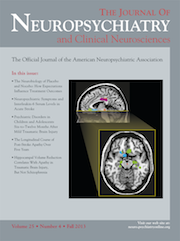Orolingual Dyskinesia and Involuntary Neck Movements Caused by Phenytoin Intoxication
To the Editor: An 88-year-old female epileptic patient was on phenytoin treatment for 40 years, however, taking her medication irregularly. Two months before admission to our department, she had a head trauma, followed by social withdrawal with decreased perception. One month later, a left fronto-parieto-temporal chronic subdural hematoma was found by cranial CT. Oral phenytoin with a dose of 300 mg/day was restarted in the Neurosurgery Department, and a surgical draining of the hematoma by burr-hole method was carried out.
The day after surgery (5th day of phenytoin treatment), she started to experience increasing levels of vertigo, gait imbalance, dysarthria, and continuous involuntary movements. On neurologic examination (26th day of phenytoin treatment), she was fully cooperative, with normal cognition. Continuous orolingual dyskinetic movements and paroxysmal backward neck movements were observed, and nystagmus was seen, with severe truncal and appendicular ataxia making her unable to sit on the bed.
A new cranial CT showed a small amount of residual hematoma in the previous area. Routine blood tests were normal. Serum phenytoin level was at toxic levels (34 mcg/ml [therapeutic range: 10–20 mcg/ml]). After cessation of phenytoin treatment, the patient was hydrated with intravenous fluids for 4 days. Drug levels returned to normal, while dyskinetic movements and cerebellar findings subsided gradually and eventually disappeared on the 4th day.
Discussion
A widely-used antiepileptic drug, phenytoin has a number of well-observed and documented side effects when prescribed in toxic doses; these include dizziness, insomnia, meningeal irritation with pleocytosis, nystagmus, ophthalmoplegia, dysarthria, ataxia, and confusion. Besides these, various involuntary movements, such as tremor, asterixis, myoclonus, and dyskinesias have been reported in these patients so far.1–3 Montenegro et al. identified one patient with axial and orofacial dyskinesia and two patients with choreoathetosis in a 1-year period, and literature shows that the main findings in phenytoin-intoxicated dyskinesic patients were choreoathetosis, dystonia, orofacial dyskinesia, and ballism, in decreasing order.4
In addition to phenytoin, other anticonvulsants that cause dyskinesia include carbamazepine, gabapentin, felbamate, and valproic acid.2 The exact pathophysiology of the occurrence of involuntary movement in phenytoin intoxication is still obscure; however, the most likely mechanism seems to be a dopaminergic, cholinergic, and serotonergic imbalance within the basal ganglia system in these patients.1–5
Brain damage has been shown to cause sensitization to the toxic effects of phenytoin.1 Examples include bilateral striatal infarction, globus pallidus calcification, frontal abscess, serious head trauma, operated meningioma, parasagittal glioblastoma, subdural hematoma, and thalamic infarction.1 After the diagnosis was made, withdrawal of the drug brought about complete disappearance of all the signs within a short time.
Conclusions
Although rarely seen, the occurrence of a new or the exacerbation of an existing movement disorder in a patient using phenytoin, regardless of serum phenytoin level, unless proven otherwise, should be evaluated as being caused by this drug, and treatment should be conducted accordingly.
1 : Phenytoin intoxication and upper facial dyskinesia: an unusual presentation. Mov Disord 2008; 23:1188–1189Google Scholar
2 : Anticonvulsants-induced chorea: a role for pharmacodynamic drug interaction? Seizure 2001; 10:596–599Crossref, Medline, Google Scholar
3 : Phenytoin and dyskinesias: a report of two cases and review of the literature. Mov Disord 1993; 8:19–27Crossref, Medline, Google Scholar
4 : Dyskinesia induced by phenytoin. Arq Neuropsiquiatr 1999; 57(2B):356–360Crossref, Medline, Google Scholar
5 : Use of biperiden hydrochloride in a child with severe dyskinesia induced by phenytoin. J Child Neurol 2003; 18:494–496Crossref, Medline, Google Scholar



